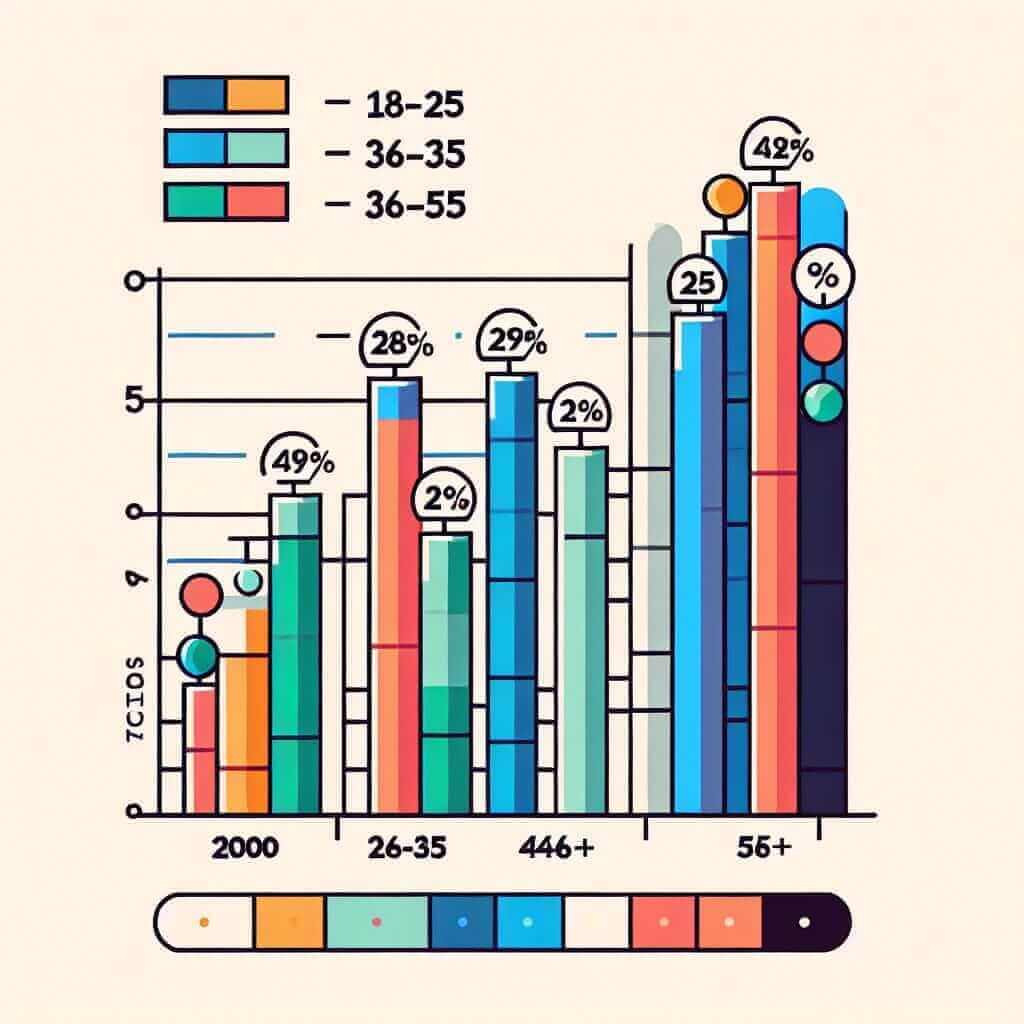The internet has become an integral part of our lives, and its usage varies significantly across different age groups. Understanding these variations is crucial, especially for students preparing for the IELTS Writing Task 1, where they may encounter tasks requiring them to interpret and compare data. This article will delve into the topic “Comparing Internet Usage in Different Age Groups (2000-2023)”—a popular subject in IELTS writing tasks—and offer detailed insights, sample questions, and a comprehensive model answer to help you excel.
Frequency of the Topic in IELTS Exams
The topic of comparing internet usage among different age groups frequently appears in IELTS Writing Task 1. You might be asked to describe trends, compare figures, or analyze changes over time.
Sample IELTS Task 1 Prompts
- Prompt 1: The chart below shows the percentage of internet users in different age groups in 2000 and 2023. Summarize the information by selecting and reporting the main features, and make comparisons where relevant.
- Prompt 2: The line graph illustrates the internet usage in different age groups from 2000 to 2023. Summarize the information by selecting and reporting the main features, and make comparisons where relevant.
- Prompt 3: The table below provides data on the internet usage percentages among different age cohorts between 2000 and 2023. Summarize the information by selecting and reporting the main features, and make comparisons where relevant.
Choosing a Sample Task
Let’s take Prompt 1 for this exercise.
Data Collection
To better understand this task, let’s create a hypothetical dataset.
Sample Bar Chart Data
Internet Usage in Different Age Groups (2000 vs. 2023)
| Age Group | 2000 | 2023 |
|———–|——|——|
| 18-25 | 30% | 90% |
| 26-35 | 25% | 85% |
| 36-45 | 20% | 70% |
| 46-55 | 10% | 60% |
| 56+ | 5% | 40% |

Task Analysis
The task here asks you to:
- Select and summarize key information.
- Compare different data points.
- Identify trends and patterns.
Model Answer
Let’s write a model answer for the chosen prompt using the provided data.
Model Answer:
The bar chart depicts the percentage of internet users across different age groups in 2000 and 2023. Overall, internet usage has increased significantly in all age cohorts over the 23-year period.
In 2000, internet penetration was highest among the 18-25 age group, with 30% of individuals using the internet. This number surged to 90% in 2023, showing a dramatic increase. Similarly, the 26-35 age group saw a substantial rise from 25% in 2000 to 85% in 2023.
The 36-45 age bracket also witnessed a notable increase, moving from 20% internet usage in 2000 to 70% in 2023. A similar trend is observed in the 46-55 age group, where internet usage grew from 10% to 60%.
The most striking change was seen in the 56+ age group, which initially had only 5% internet users in 2000. By 2023, this figure had climbed to 40%, marking an eightfold increase.
In summary, the data illustrates a significant growth in internet usage across all age groups, with the younger age groups consistently leading in internet adoption.
Word Count: 190 words
Key Considerations for Writing
When writing about this topic, keep the following in mind:
- Vocabulary Range: Use varied vocabulary to describe changes and comparisons, such as “increase,” “rise,” “grow,” “significant,” and “dramatic.”
- Sentence Structures: Employ complex sentences to clearly explain trends and comparisons.
- Data Interpretation: Focus on the most relevant data points and avoid unnecessary details.
Vocabulary List
- Penetration (n.) /ˌpɛnɪˈtreɪʃ(ə)n/: The extent to which something is adopted or used.
- Cohort (n.) /ˈkəʊhɔːt/: A group of people sharing a common characteristic.
- Surge (v.) /səːdʒ/: To increase suddenly and markedly.
- Notable (adj.) /ˈnəʊtəbl/: Worthy of attention or notice; remarkable.
- Dramatic (adj.) /drəˈmatɪk/: Sudden and striking.
Conclusion
To excel in IELTS Writing Task 1, you need to clearly understand the given data, identify key trends, and make effective comparisons. By practicing with sample prompts and following structured writing strategies, you can aim for a high band score in your IELTS exam.